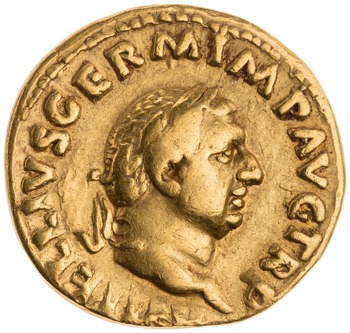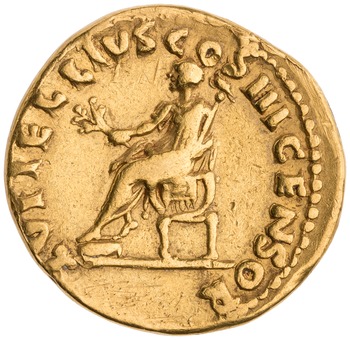Roman Empire (27 BC - 395 AD) Aureus - Vitellius and Lucius Vitellius Pater (L VITELLIVS COS III CENSOR)
Introduction
The Aureus depicting Vitellius and Lucius Vitellius Pater is a remarkable piece of Roman numismatic history. Minted in 69 AD, this gold coin stands out for its intricate design and historical significance, making it a coveted collectible among numismatists worldwide.
Historical Background
During the tumultuous Year of the Four Emperors in 69 AD, Vitellius briefly held the imperial throne. This coin, showcasing his laureate head on the obverse, symbolizes his short-lived reign. The reverse features Lucius Vitellius seated on a curule chair, a symbol of authority, holding an eagle-tipped scepter, reflecting the power dynamics of the time.
Coin Images
 Obverse
Obverse
 Reverse
Reverse
Design Features
The obverse of the coin presents a striking portrayal of Vitellius, adorned with a laurel wreath, facing right. This depiction exudes authority and captures the essence of Roman portraiture during this period. On the reverse, Lucius Vitellius is depicted in a toga, seated on a curule chair, a traditional symbol of Roman magistracy. His gesture of extending his hand and holding the scepter adds a touch of gravitas to the design.
Technical Specifications
This 1 Aureus gold coin weighs 7.20 grams and has a diameter of 19.00mm, reflecting the standard specifications of Roman Aurei. Crafted from pure gold, this coin exemplifies the exquisite craftsmanship of Roman minting techniques during this era.
Collectible Value
Due to its historical significance and rarity, the Aureus featuring Vitellius and Lucius Vitellius holds immense collectible value. These coins are highly sought after by collectors, commanding significant prices in the numismatic market. The limited availability of this coin adds to its allure, making it a prized possession for enthusiasts of Roman coinage.
Conclusion
In conclusion, the Aureus depicting Vitellius and Lucius Vitellius Pater is a numismatic treasure that encapsulates a pivotal moment in Roman history. Its intricate design, historical context, and rarity make it a valuable addition to any coin collection. This coin serves as a tangible link to the past, allowing collectors to own a piece of the Roman Empire's rich numismatic legacy.

